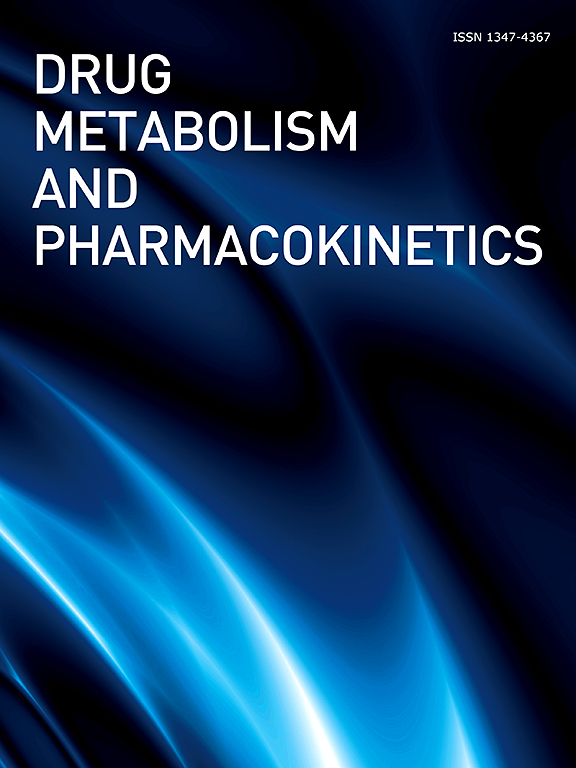皮下给药后皮下组织和淋巴液降解对fc融合蛋白吸收的影响
IF 2.2
4区 医学
Q2 PHARMACOLOGY & PHARMACY
引用次数: 0
摘要
皮下给药作为fc融合蛋白的临床给药途径被广泛使用。然而,由于吸收过程中涉及多种因素,预测皮下给药后人体的生物利用度(BA)具有挑战性。本研究旨在阐明降解对fc融合蛋白BA的影响。我们建立了两种检测Fc融合蛋白的方法:识别Fc区域的Fc/Fc方法;以及同时识别蛋白质和Fc区域的蛋白质/Fc方法。用Fc/Fc法测定大鼠dulaglutide和romiplostim的BA分别为80.1%和99.4%,用Protein/Fc法测定大鼠BA分别为35.0%和55.5%。蛋白质/Fc法的低BA表明蛋白质区域在吸收过程中发生了降解。在大鼠皮肤匀浆和淋巴液的稳定性研究中,证实了dulaglutide和romiplostim的蛋白区降解,蛋白酶抑制剂抑制了这种降解。相比之下,阿巴接受和依那西普在皮肤匀浆和淋巴液中是稳定的,它们在大鼠中的BA在Fc/Fc和蛋白质/Fc方法中是相当的。本研究表明,在吸收过程中是否存在蛋白酶介导的降解是影响fc融合蛋白BA的因素之一。本文章由计算机程序翻译,如有差异,请以英文原文为准。
Impact of degradation in subcutaneous tissue and lymphatic fluid on absorption of Fc-fusion proteins following subcutaneous administration
Subcutaneous administration is widely used as a clinical administration route for Fc-fusion proteins. However, predicting bioavailability (BA) in humans after subcutaneous administration is challenging due to multiple factors involved in the absorption process. This study aimed to elucidate the impact of degradation on the BA of Fc-fusion proteins. We established two measurement methods for each Fc-fusion protein: the Fc/Fc method, which recognizes the Fc region; and the Protein/Fc method, which recognizes both protein and Fc region. BA of dulaglutide and romiplostim in rats were 80.1 % and 99.4 % by the Fc/Fc method, and 35.0 % and 55.5 % by the Protein/Fc method, respectively. The lower BA with the Protein/Fc method indicates that the protein region undergoes degradation during the absorption process. In stability studies with rat skin homogenates and lymphatic fluid, degradation of the protein region for both dulaglutide and romiplostim was confirmed, which was inhibited by protease inhibitors. In contrast, abatacept and etanercept were stable in skin homogenates and lymphatic fluid, and their BA in rats were comparable between the Fc/Fc and Protein/Fc methods. This study indicates that the presence or absence of protease-mediated degradation during the absorption process is one of the factors affecting the BA of Fc-fusion proteins.
求助全文
通过发布文献求助,成功后即可免费获取论文全文。
去求助
来源期刊
CiteScore
4.80
自引率
9.50%
发文量
50
审稿时长
69 days
期刊介绍:
DMPK publishes original and innovative scientific papers that address topics broadly related to xenobiotics. The term xenobiotic includes medicinal as well as environmental and agricultural chemicals and macromolecules. The journal is organized into sections as follows:
- Drug metabolism / Biotransformation
- Pharmacokinetics and pharmacodynamics
- Toxicokinetics and toxicodynamics
- Drug-drug interaction / Drug-food interaction
- Mechanism of drug absorption and disposition (including transporter)
- Drug delivery system
- Clinical pharmacy and pharmacology
- Analytical method
- Factors affecting drug metabolism and transport
- Expression of genes for drug-metabolizing enzymes and transporters
- Pharmacogenetics and pharmacogenomics
- Pharmacoepidemiology.

 求助内容:
求助内容: 应助结果提醒方式:
应助结果提醒方式:


